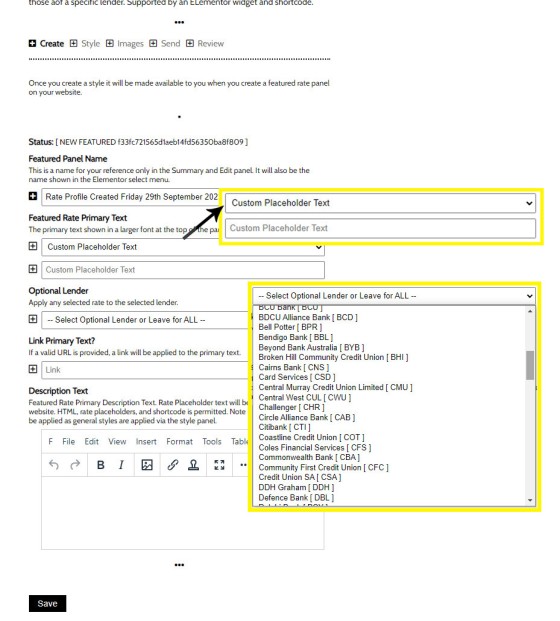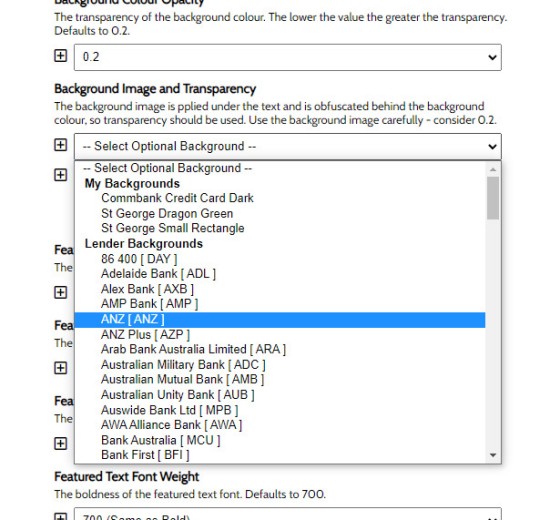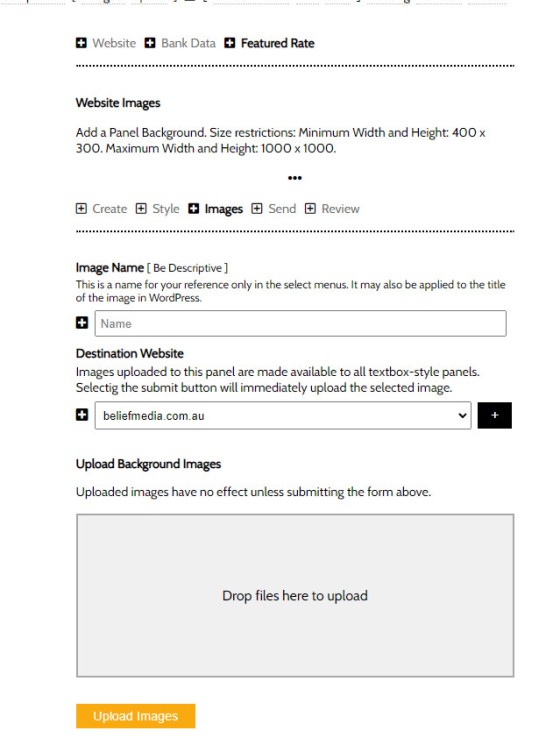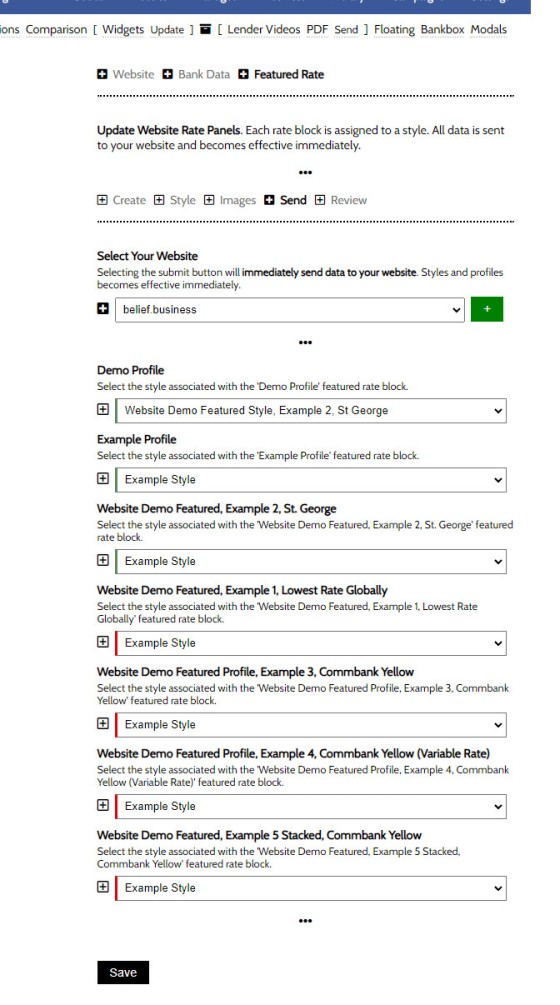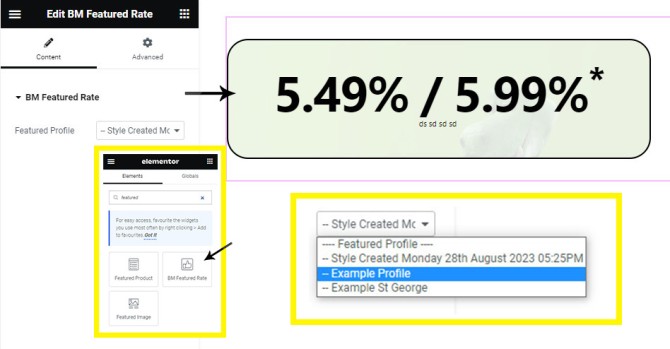The Featured Rates Panel is one of nearly 30 tools used to render lender data and comparison information, and it is one of two panels used to return 'Featured' rate data in a manner similar to that which we're about to describe. The 'other' featured rate panel' is somewhat of a legacy Elementor-only feature. The featured rates block is not used anywhere on your website by default, so inclusion requires that you manage the asset yourself.
Pictured: To find the Featured Rate options, you should navigate via the 'Lender' icon in the Website module. Selecting it returns most Lender options. Scroll down the page to find the 'Featured Rate' menu options  .
.
Rendering a result requires that we create a profile, which is the basic rate and text options, and a style, with the latter determining how the rate will render. Usage is via shortcode or an Elementor drag-and-drop block.
The Result
For the first example, we'll look at the typical lowest rate that many brokers rightly or wrongly show on their entry page (and this is where the requesting client required the basic rate text). The result of the shortcode [bm_featured_rate profile="ef52f9bbf0e5fca721096e2ec7e8d293"] returns the following:
The reference ID of ef52f9bbf0e5fca721096e2ec7e8d293 is recorded in Yabber as a shortcode. The basic text-only style shown above is the expected usage. For those that insist on using prominent call-to-action rate text on page entry, this is the general style that should be applied.
In the second example we'll use the lowest CommBank owner occupied variable rate  against a plain 'box' background
against a plain 'box' background  . We've also linked the rate to an internal page.
. We've also linked the rate to an internal page.
An optional background image  may be applied the container as shown below. In this case we've selected the lowest variable rate made available from Commbank.
may be applied the container as shown below. In this case we've selected the lowest variable rate made available from Commbank.
The rate may also be 'stacked'. When a stacked rate is selected and a default lender background  image is used (or an image you haven't uploaded yourself), we'll default to the 'square' lender logo rather than the wide version. When stacking rates and applying a background, image it make more sense to create your own 'true' square image and upload it via the image panel
image is used (or an image you haven't uploaded yourself), we'll default to the 'square' lender logo rather than the wide version. When stacking rates and applying a background, image it make more sense to create your own 'true' square image and upload it via the image panel  , as the default image is the same logo we use to render rate data, so it isn't entirely suitable.
, as the default image is the same logo we use to render rate data, so it isn't entirely suitable.
Stacked rates might be suitable in a sidebar or similar when making attempts to funnel a user through to the conversion archives (applied to 100% width  rather than a defined pixel width as used in the above example).
rather than a defined pixel width as used in the above example).
For the third example, we'll apply a background image  and restrict lenders to St. George
and restrict lenders to St. George  (Owner Occupied Variable Rate). The styling looks a little ridiculous because we've exaggerated the branding.
(Owner Occupied Variable Rate). The styling looks a little ridiculous because we've exaggerated the branding.
Our examples are very ordinary in terms of presentation, but the styling options allow you to create virtually any design. As mentioned earlier, in most cases you'll simply use the naked rate text.
Creating a Rate Profile
The Rate Profile includes the rate type, the rate, the lender(s), an optional link, and the primary paragraph text.
Pictured: The Rate Profile  includes the rate type, the rate, the lender(s), an optional link, and the primary paragraph text. If placeholders are used in 'Custom Text' (as shown above), you should reference the Rate Placeholders.
includes the rate type, the rate, the lender(s), an optional link, and the primary paragraph text. If placeholders are used in 'Custom Text' (as shown above), you should reference the Rate Placeholders.
If placeholders are used in 'Custom Text' (as shown in the image above), you should reference the Rate Placeholders.
Creating a Rate Style
The Rate Style determines how your featured rate is shown.
Pictured: The Rate Style determines how your featured rate is shown. While options may seem daunting, it is intuitive and alterations are rarely required. Most of the options are provided for granular control - you are unlikely to ever need them.
While options may seem daunting, it is intuitive and alterations are rarely required.
Uploading a Featured Rate Background Image
In the style options shown above, you will note an option for a panel background image. This image is uploaded to your website via Yabber, and it will then be made available in the Style panel.
Pictured: In the style options shown above, you will note an option for a panel background image. the select menu includes those images you upload yourself and default lender images.
To upload an image, do so via the 'Images' panel. Upload an image, give it a name, and Save. Images that are no longer required may be 'disabled' via the 'Review' panel.
Pictured: To upload an image, do so via the 'Images' panel. Upload an image, give it a name, and Save. Images that are no longer required may be 'disabled' via the 'Review' panel.
Note that the image is website dependant - an image will send to your website's image library.
Sending Featured Rate Data to Your Website
Yabber is a multi-website platform, so we must send data to our specific website. Do so via the 'Send' panel.
Pictured: Yabber is a multi-website platform, so we must send data to our specific website. Do so via the 'Send' panel. You should assign each Featured Rate panel to a style, and Send.
You should assign each Featured Rate panel to a style, and Send. Those Featured Rate Profiles with an unassigned style are shown with a red border.
Featured Rate Elementor Block
In the case of most of our rate features, the easiest method of inclusion is via the use of a drag-and-drop Elementor block. In the case of the featured rate, the shortcode is easily applied  and doesn't include an array of attributes, so it's probably the preferred method (the linked image shows the 'Review' page which includes the full list of profiles and styles for review and editing).
and doesn't include an array of attributes, so it's probably the preferred method (the linked image shows the 'Review' page which includes the full list of profiles and styles for review and editing).
If building a full page, the Elementor block is available. Search for 'BM Featured Rate', drag into any post or page, and then select the applicable profile as defined in Yabber (remember, a style will be applied to this profile already, so there are no Elementor options).
Pictured: Search Elementor for 'Featured', select the 'BM Featured Rate' block, drag onto your page, and select the applicable profile. The results is immediately rendered and rate data will always remain up-to-date.
The widget is made available in Version 0.9.5 of the 'BeliefMedia Elementor' plugin.
■ ■ ■
Related Lender Data FAQs
Related FAQs and features relating to Lender Data. The Lender features tends to touch most modules, so only primary FAQ modules are shown.
There are a large number of ways in which to return various heading content blocks on your website, such as headings, titles, statements, blocks - most of which are listed below this FAQ in the related section. However, these assets are usually used in the design of certain pages - most notably landing pages -… [ Learn More ]
You have a best interest duty requirement imposed upon you that essentially mandates you quickly communicate rate data to your clients - first when the board makes a cash rate decision, and then later when changes are made, or when repricing might be appropriate. Yabber provide a basic facility to create an RBA Cash Rate… [ Learn More ]
One of the features of Yabber that is less visible than others is the lender rate email signature. The signature is an image that may be used in an email signature to return the lowest rate of a specific type. Yabber provides links to the direct image and will also create a HTML link for… [ Learn More ]
All rate data returned via Yabber will automatically segregate the requested 'standard' products from those 'conditional' products, such as green finance or leveraged residential lending against a business product. In all cases where we've had feedback from users and the validity of rates was questioned, the product has existed and was entirely valid, but the… [ Learn More ]
In an FAQ titled we looked at how to assign videos to the and Pages on your website. Familiarity with the former module is required, as this FAQ will simply show you how to link directly to a video that was assigned to a specific lender in that modules. Confused yet? This feature is one… [ Learn More ]
In a previous FAQ we introduced how to define the single video for your website . However, this is the top-level that effectively acts as a conduit to the Lenders Archive Pages and the thousands of Lender Product Pages. Each of the specific Lender Archive Pages, and all of the pages associated with that lender,… [ Learn More ]
The Lender Archive Video is a shown on the entry . It is important for the purpose of amplifying funnel enthusiasm and introducing your website visitors to the purpose of the vast information archives you make available. The video should always include an appropriate call-to-action, appropriate disclaimers, and other helpful information. Remember, the primary purpose… [ Learn More ]
We've said it over and over again, but we'll say it again regardless. You don't want to be a rate-driven broker, and you don't want to attract rate-focused mortgage customers. However, that doesn't mean that we selectively deliver self-serving information on our website or in the funnel at the expense of the information that well… [ Learn More ]
There are a couple of dozen different ways to show Lender Data on your website, and the floating Lender Panel is just another one of them. The panel is also a feature that you're not likely to use. We'll often say that we have to serve information on our website that the consumer wants and… [ Learn More ]
The Modal Module made available in Yabber is an incredibly powerful feature that provides enormous flexibility in how and when we interrupt the funnel in order to provide appropriate course correction. The system is supplemented by a linking feature that permits you to link directly to any modal manicured within the system. In order to… [ Learn More ]
Lender Modals are popups shown based on the lender pages on your website. Each lender is assigned to a 'Lender Group' with a group consisting of a single lender or multiple lenders, and the defined modal will show when a user visits the specific on your website. A default lender modal will shown on the… [ Learn More ]
The inclusion of transactional account data on your website is important because it's part of a mortgage product that a consumer will interact with every single day. In terms of our compliance obligations, only those transactional accounts that are associated with lender products may be shown, and this effectively includes every transactional account made available… [ Learn More ]
Business Finance is an important part of your business model, and the lending is a gateway loan into typical residential lending. The business finance products made available on your website are sourced from your accredited lenders. This FAQ will details how to include a Business Finance Lender Widget anywhere on your website. The Business Finance… [ Learn More ]
Personal Loans are a getaway into other types of lending, so it's something that your business shouldn't ignore. It's a common type of finance that is widely used, and one that takes very little time to process. Your website includes various pages for personal vehicle, maritime, motorcycle, caravan, aircraft, and other types of specific assets,… [ Learn More ]
Margin lending is a type of loan that allows you to borrow money to invest, by using your existing shares, managed funds and/or cash as security. It is a type of gearing, which is borrowing money to invest. We've consulted with ASIC to determine if it's acceptable from a compliance perspective to include details of… [ Learn More ]
Despite the ubiquitous industry rhetoric suggesting that sharing rates on your website will only attract 'rate chasers' (partially true, but outside the scope of this FAQ), the rate information shared on your website will objectively attract and convert more mortgage clients. Used in company with other Lender Rate features, your powerful website presence will quickly… [ Learn More ]
Despite the ubiquitous industry rhetoric suggesting that sharing rates on your website will only attract 'rate chasers' (partially true, but outside the scope of this FAQ), the rate information shared on your website will objectively attract and convert more mortgage clients. Used in company with other Lender Rate features, your powerful website presence will quickly… [ Learn More ]
A number of FAQs make reference to 'Lowest Rate Placeholders'. Placeholders are a string of text that is replaced in many blocks of text with the lowest available rate of a specific type from your accredited lenders. The placeholders shown below are in no way definitive - in fact, they're just one style of placeholder,… [ Learn More ]
The Lender Widgets on your website are one of your most powerful website features. Despite the ubiquitous industry rhetoric suggesting that sharing rates will only attract 'rate chasers' (partially true, but outside the scope of this FAQ), the rate information shared on your website will objectively attract and convert more mortgage clients. Used in company… [ Learn More ]
Quite frankly, the Lender Archive Page link shortcode is rather pointless because the standard link shortcode is arguably more effective. The reason it exists is because we have other plans for how the shortcode is to be used. So, if you're linking to a specific lender archive, such as that for the , use the… [ Learn More ]
The Lender Widgets on your website are one of your most powerful website features. Despite the ubiquitous industry rhetoric suggesting that sharing rates will only attract 'rate chasers' (partially true, but outside the scope of this FAQ), the rate information shared on your website will objectively attract and convert more mortgage clients. Used in company… [ Learn More ]
The Lender Library is an unusual page. It was once a hidden page on broker websites that was used almost exclusively by brokers. It has since become a standard public page within the website framework. The article in our blog titled "Mortgage Broker Lender Document and Media API, and Lender Documents Elementor Block" should be… [ Learn More ]
In order to represent your panel of lenders on your website, most brokers will use a silly slider of static images, and others will use a single fixed image comprised of multiple images - just a lazy solution. Your website includes a grid of images that links to the application that'll showcase the primary and… [ Learn More ]
The Featured Product panel is a means to provide an array of information on a single product. The information may be shaped in numerous formats which is guided by the Elementor plugin options. As is expected from any finance professional, the rate data (and other product data) is always maintained to reflect the current rate.… [ Learn More ]
Like it or not (and most brokers don't), rates play a huge part in attracting the early attention of your website visitors. You will attract more traffic and you will attract more clients. What you do next will unlikely be rate focused, but our early efforts should be focused on creating conversations. We include rate… [ Learn More ]
The Featured Rates Panel is one of nearly 30 tools used to render lender data and comparison information, and it is one of two panels used to return 'Featured' rate data in a manner similar to that which we're about to describe. The 'other' ' is somewhat of a legacy Elementor-only feature. The featured rates… [ Learn More ]
There's a Rate Ribbon on the front page of your website below the centre-fold block that presents the lowest rates of various types. The purpose of the ribbon is to position yourself as a broker, showcase your digital expertise, and create early funnel pathways. Each rate shown in the ribbon links to the relevant that… [ Learn More ]
The single line rate bar is shown on the broker website framework by default as part of the header and in the centre of the front page. The purpose is to position yourself as a broker, differentiate yourself from the 'others', showcase lowest available rates from your accredited lenders, and create website pathways. This FAQ… [ Learn More ]
The Published versus Comparison Rate graph was created to support a single FAQ on 'What is a Comparison Rate', but the graph often finds value elsewhere. To include the graph on your page, use the shortcode of . The Result: The graph simply illustrates how the published rate is often vastly different to the comparison… [ Learn More ]
There are times where you will need to return the current cash rate into your website (often in your website footer as a quick reference). The shortcode of will return % (bolding is ours). Simple. Note that the current cash rate is always shown in the header of your website. This panel links to a… [ Learn More ]
All queries to lender data is measured against your accredited lenders. Once our accredited lenders are defined in Yabber, all queries from each of your specific websites will only return data from those lenders as defined in Yabber. Lenders are added to the system regularly and data is generally updated daily. Access the Lender Data… [ Learn More ]



